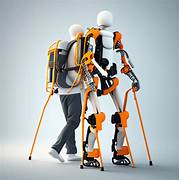AI in Robotic Exoskeletons for Physical Rehabilitation
Artificial intelligence (AI) has revolutionized numerous industries, and healthcare is no exception. One of the most promising applications of AI in healthcare is its integration into robotic exoskeletons for physical rehabilitation. These advanced devices are designed to aid individuals recovering from injuries, surgeries, or neurological conditions, offering a blend of physical support and intelligent adaptation.
This article explores the role of AI in robotic exoskeletons, their benefits, challenges, and the potential they hold for transforming physical rehabilitation.
What Are Robotic Exoskeletons?
Robotic exoskeletons are wearable, powered devices designed to assist or augment human movement. They typically consist of a mechanical frame fitted with actuators, sensors, and control systems. By mimicking or supporting human motion, these devices can:
- Help individuals regain mobility.
- Enhance muscle strength and coordination.
- Prevent secondary complications during rehabilitation.
When combined with AI, these devices become smarter and more adaptive, offering tailored rehabilitation solutions for patients with varying needs.
The Role of AI in Robotic Exoskeletons
Artificial intelligence elevates robotic exoskeletons from simple mechanical aids to intelligent systems capable of personalized care. Here’s how AI contributes:
1. Real-Time Data Processing
AI algorithms analyze data from sensors embedded in the exoskeleton to monitor patient movements, detect abnormalities, and adjust assistance in real time.
2. Adaptive Learning
Using machine learning, the exoskeleton adapts to the patient’s progress over time, modifying resistance, support levels, or speed to match their evolving needs.
3. Motion Prediction
AI-powered systems can predict a user’s intended movement by analyzing neural signals or motion patterns, enabling smoother and more natural assistance.
4. Feedback Mechanisms
Robotic exoskeletons equipped with AI provide immediate feedback to patients and therapists, offering insights into performance and suggesting improvements.
5. Remote Monitoring and Control
Through AI integration, exoskeletons can be connected to cloud systems, allowing therapists to monitor patient progress remotely and adjust settings as needed.
Applications of AI-Driven Robotic Exoskeletons in Rehabilitation
1. Neurological Rehabilitation
Patients recovering from strokes, spinal cord injuries, or traumatic brain injuries often experience motor impairments. AI-driven exoskeletons assist by:
- Encouraging repetitive, task-specific movements critical for neuroplasticity.
- Adapting support based on the patient’s recovery stage.
- Monitoring muscle activity and neural responses to optimize therapy.
2. Orthopedic Rehabilitation
After surgeries like knee replacements or fractures, patients require extensive physical therapy to regain strength and mobility. Robotic exoskeletons aid by:
- Supporting weight-bearing exercises.
- Ensuring correct movement patterns to prevent re-injury.
- Gradually increasing resistance as muscles strengthen.
3. Geriatric Rehabilitation
Older adults often face mobility challenges due to conditions like arthritis or degenerative diseases. AI-powered exoskeletons:
- Provide gentle assistance to reduce strain on joints.
- Promote independence in daily activities.
- Prevent falls by offering stability and balance support.
4. Pediatric Rehabilitation
For children with developmental disorders or physical disabilities, exoskeletons:
- Facilitate motor skill development.
- Offer playful, engaging therapy sessions.
- Adjust dynamically to suit the smaller frame and unique needs of children.
Benefits of AI in Robotic Exoskeletons
1. Personalized Rehabilitation
AI algorithms enable exoskeletons to tailor therapy based on individual patient profiles, ensuring maximum efficacy.
2. Enhanced Precision
By analyzing sensor data in real time, AI ensures that movements are accurate and aligned with therapy goals.
3. Faster Recovery
Intelligent adaptation and continuous feedback help patients progress more quickly through rehabilitation phases.
4. Reduced Therapist Workload
AI-driven exoskeletons automate routine tasks, allowing therapists to focus on complex aspects of patient care.
5. Data-Driven Insights
The data collected by AI systems provides valuable insights into patient progress, helping therapists refine treatment plans.
6. Cost-Effective Solutions
While the initial cost of robotic exoskeletons is high, their efficiency in delivering therapy can reduce long-term healthcare costs.
Challenges and Limitations
Despite their potential, AI-driven robotic exoskeletons face several challenges:
1. High Costs
Developing and deploying these advanced devices involves significant expenses, limiting accessibility for many patients and healthcare facilities.
2. Technical Complexity
The integration of AI into exoskeletons requires sophisticated algorithms and hardware, posing challenges in development and maintenance.
3. Limited Adaptability for Severe Cases
Patients with severe disabilities or highly specific needs may require further advancements in AI technology to benefit fully.
4. Ethical Concerns
The collection and storage of patient data by AI systems raise privacy and security issues.
5. User Acceptance
Some patients may be hesitant to trust or adopt robotic systems due to fear of technology or unfamiliarity.
6. Training and Support
Healthcare professionals require specialized training to use and maintain these devices effectively.
Case Studies: Real-World Applications
1. Ekso Bionics
Ekso Bionics developed AI-driven exoskeletons for stroke and spinal cord injury rehabilitation. Their devices use machine learning to adapt to the patient’s needs, promoting faster recovery.
2. ReWalk Robotics
ReWalk offers robotic exoskeletons for individuals with lower limb disabilities. Their systems use AI to analyze gait patterns and provide personalized assistance.
3. SuitX
SuitX exoskeletons, designed for industrial and medical applications, leverage AI to enhance mobility and reduce fatigue in users.
Future of AI in Robotic Exoskeletons
The future of AI-driven robotic exoskeletons holds immense promise. Key trends include:
1. Integration with Brain-Computer Interfaces (BCIs)
Combining AI with BCIs will enable exoskeletons to interpret neural signals, offering direct control and more intuitive assistance.
2. Advanced Machine Learning Models
Future AI systems will analyze more complex datasets, improving adaptability and precision in rehabilitation.
3. Affordable Solutions
As technology advances, production costs are expected to decrease, making these devices accessible to a broader population.
4. Collaborative Robotics
Exoskeletons will work seamlessly with other assistive technologies, creating integrated rehabilitation ecosystems.
5. Enhanced Connectivity
5G and IoT integration will enable real-time data sharing and remote therapy sessions, further enhancing the utility of these devices.
Conclusion
AI-driven robotic exoskeletons are redefining the landscape of physical rehabilitation. By offering personalized, precise, and adaptive support, these devices empower patients to achieve better outcomes while reducing the burden on healthcare professionals.
However, challenges like high costs, technical complexities, and ethical concerns must be addressed to unlock their full potential. As technology evolves, the integration of AI into robotic exoskeletons will continue to advance, paving the way for a future where rehabilitation is more effective, accessible, and transformative.
Through innovation and collaboration, AI-powered exoskeletons are poised to become indispensable tools in the journey toward recovery and mobility.


